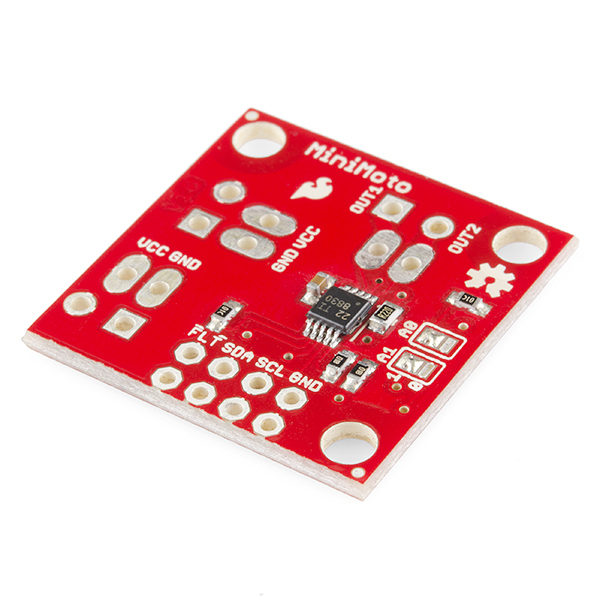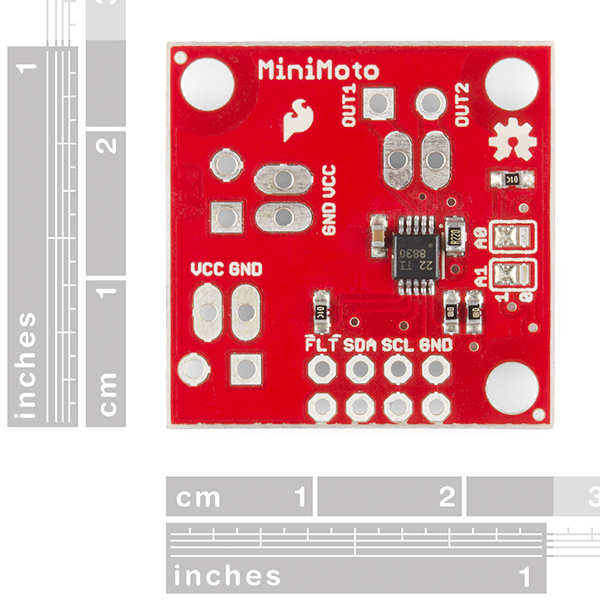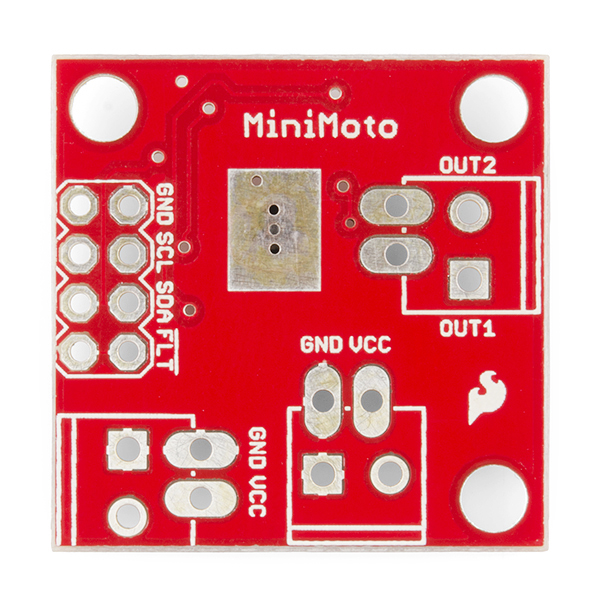SparkFun MiniMoto Breakout - DRV8830
The SparkFun MiniMoto is a great little breakout for the DRV8830 I2C DC motor driver. The MiniMoto is great for driving most small robotics. With an operating voltage range of 2.7V to 6.8V and a current limit of 1A the DRV8830 is a versatile little driver.
In addition to the benefit of being controlled via I2C, which frees up data lines and processing on the CPU to be used for other tasks, the MiniMoto has the lowest voltage output capability of any current SparkFun DC motor driver. This means that low voltage systems running on LiPo batteries and low voltage motors can both be used with the MiniMoto.
- H-Bridge Voltage-Controlled Motor Driver
- 1A Peak Drive Current
- 2.7V to 6.8V Operating Supply Voltage Range
- Serial I2C Compatible Interface
- Dataline Supports up to 9 MiniMotos
- Schematic
- Eagle Files
- Hookup Guide
- Datasheet (DRV8830)
- GitHub (Example Code & Design Files)
- GitHub (Library)
SparkFun MiniMoto Breakout - DRV8830 Product Help and Resources
Core Skill: Soldering
This skill defines how difficult the soldering is on a particular product. It might be a couple simple solder joints, or require special reflow tools.
Skill Level: Rookie - The number of pins increases, and you will have to determine polarity of components and some of the components might be a bit trickier or close together. You might need solder wick or flux.
See all skill levels
Core Skill: Robotics
This skill concerns mechanical and robotics knowledge. You may need to know how mechanical parts interact, how motors work, or how to use motor drivers and controllers.
Skill Level: Rookie - You will be required to know some basics about motors, basic motor drivers and how simple robotic motion can be accomplished.
See all skill levels
Core Skill: Programming
If a board needs code or communicates somehow, you're going to need to know how to program or interface with it. The programming skill is all about communication and code.
Skill Level: Competent - The toolchain for programming is a bit more complex and will examples may not be explicitly provided for you. You will be required to have a fundamental knowledge of programming and be required to provide your own code. You may need to modify existing libraries or code to work with your specific hardware. Sensor and hardware interfaces will be SPI or I2C.
See all skill levels
Core Skill: Electrical Prototyping
If it requires power, you need to know how much, what all the pins do, and how to hook it up. You may need to reference datasheets, schematics, and know the ins and outs of electronics.
Skill Level: Rookie - You may be required to know a bit more about the component, such as orientation, or how to hook it up, in addition to power requirements. You will need to understand polarized components.
See all skill levels
Comments
Looking for answers to technical questions?
We welcome your comments and suggestions below. However, if you are looking for solutions to technical questions please see our Technical Assistance page.
Customer Reviews
No reviews yet.





Will the library that comes with this board work with a Teensy?
Probably not; some of the implementation is aimed at the Atmega processor family.
Hi there,
So, would this work out of the box with a Raspberry Pi? I have one and I'm trying to control more DC motors than the GPIO can support and thus need an I2C board that can control a DC motor rather than a servo or stepper. That way I can then chain together the number I need (6 of them to be exact).
I can't think why it wouldn't, although I haven't tried.
I don't suppose this library could be adapted for ATtiny? It'd be a sweet diminutive robot controller.
It could, pretty easily in fact, since I didn't use a lot of the built-in Arduino functionality (or almost any, in fact).
Try removing the includes for "Arduino.h" and compiling it as a part of your ATTiny project. As long as your Tiny supports I2C, there's a good chance all the register and bit names will be consistent between the Mega328 and your part, and the code may just compile.
I was able to get your code to work using SoftI2CMaster and an ATtiny 85. I couldn't seem to get the USI on the Tinies to do what I wanted.
http://letsmakerobots.com/node/40186
Did your "Getting Started" and "Github" pages move? I'm getting a Page Not Found error messages when I click on your links. Otherwise, keep up the great work.
same issue here. Can't find the library on github through the link or browsing sparkfun's github page.
Looks like the GitHub bit's gone (probably just missed in the overhaul), but the library itself can still be downloaded directly through the MiniMoto Library link above. ( Phil also mentioned the Getting Started link being broken, that seems fine here now, though many links within are also broken. )
Can we get this in a higher voltage/higher current version? I like the I2C control on here and none of the other motor drivers have it.
Here's the Grove L298 http://www.trossenrobotics.com/p/grove-l298-i2c-motor-driver.aspx It's pretty much the only other i2c H-bridge I'm aware of. It would nice to see similar higher-voltage i2c h-bridge from Sparkfun.